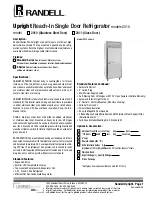
8
Water Supply Requirements
■
All installations must meet local plumbing code requirements.
■
The water shutoff should be located in the base cabinet on
either side of the refrigerator or some other easily accessible
area. The right-hand side is recommended. The access hole
through the cabinet must be within
¹⁄₂
" (12.7 mm) of the rear
wall.
NOTE: If the water shut off valve is in the back wall behind the
refrigerator, it must be at an angle so that the tube is not
kinked when the refrigerator is pushed into its final position.
■
If the water shutoff valve is not in the cabinets, the plumbing
for the water line can come through the floor. A
¹⁄₂
" (12.7 mm)
hole for plumbing should be drilled at least 6" (15.2 cm) from
the right or left hand side cabinet or panel. On the floor, the
hole should be no more than 1" (2.54 cm) away from the back
wall. See “Connect the Water Supply.”
■
If additional tubing is needed, use copper tubing and check
for leaks. Install the copper tubing only in areas where the
household temperatures will remain above freezing.
■
Do not use a piercing-type or
³⁄₁₆
" (4.76 mm) saddle valve
which reduces water flow and clogs more easily.
NOTE: Your refrigerator dealer has a kit available with a
¹⁄₄
"
(6.35 mm) saddle-type shutoff valve, a union, and copper
tubing. Before purchasing, make sure a saddle-type valve
complies with your local plumbing codes.
Water Pressure
A cold water supply with water pressure between 30 and 120 psi
(207 and 827 kPa) is required to operate the water dispenser and
ice maker. If you have questions about your water pressure, call a
licensed, qualified plumber.
Reverse Osmosis Water Supply
IMPORTANT: The pressure of the water supply coming out of a
reverse osmosis system going to the water inlet valve of the
refrigerator needs to be between 30 and 120 psi
(207 and 827 kPa).
If a reverse osmosis water filtration system is connected to your
cold water supply, the water pressure to the reverse osmosis
system needs to be a minimum of 40 to 60 psi (276 to 414 kPa).
If the water pressure to the reverse osmosis system is less than
40 to 60 psi (276 to 414 kPa):
■
Check to see whether the sediment filter in the reverse
osmosis system is blocked. Replace the filter if necessary.
■
Allow the storage tank on the reverse osmosis system to refill
after heavy usage.
■
If your refrigerator has a water filter cartridge, it may further
reduce the water pressure when used in conjunction with a
reverse osmosis system. Remove the water filter cartridge.
If you have questions about your water pressure, call a licensed,
qualified plumber.
Tipping Radius
Be sure there is adequate ceiling height to stand the refrigerator
upright when it is moved into place.
■
The dolly wheel height must be added to the tipping radius
when a dolly is used.
■
If needed, the tipping radius can be reduced. See “Reduce
Tipping Radius.”
Side Tipping Radius
The side tipping radius varies depending upon the width of the
model. Use the chart provided to determine the side tipping
radius.
NOTE: Tip on side only.
24"
(60.96 cm) min.
1"
(2.54 cm)
6"
(15.2 cm)
6"
(15.2 cm)
6"
(15.2 cm)
Model
Tipping Radius A
36
42
48
90
¹⁄₂
" (229.9 cm)
93" (236.2 cm)
96" (243.8 cm)
A









































